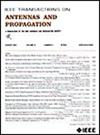基于线性到圆形极化分解反射面的多功能极化转换器
IF 4.6
1区 计算机科学
Q1 ENGINEERING, ELECTRICAL & ELECTRONIC
引用次数: 0
摘要
本文基于线-圆偏振分解的概念,提出了一种实现多功能反射面偏振转换器的新型设计策略。通过将线性极化入射波分解为一对正交圆极化波,即右手圆极化波(RHCP)和左手圆极化波(LHCP),并独立控制两个圆极化分量的相位状态,可实现各种极化转换功能。我们提出了一种由方形贴片和 90° 混合耦合器组成的反射面单元单元,以促进线性到圆极化的分解,通过在混合耦合器末端添加不同的移相器来调整两个圆极化分量的相位状态。基于所提出的反射面单元单元,实现了三种不同的功能,包括线性到双极化转换、同步线性极化旋转和波束转向以及雷达截面(RCS)减小。通过全波仿真和实验,对所提出的设计策略进行了理论分析,并通过与三种功能相对应的三个反射面进行了演示。本文章由计算机程序翻译,如有差异,请以英文原文为准。
Multifunctional Polarization Converters Based on Linear-to-Circular Polarization Decomposition Reflective Surfaces
This article proposes a novel design strategy to realize multifunctional reflective surface polarization converters based on the concept of linear-to-circular polarization decomposition. By decomposing the linearly polarized incident wave into a pair of orthogonal circularly polarized waves, namely, a right-handed circularly polarized (RHCP) wave and a left-handed circularly polarized (LHCP) wave, and controlling the phase states of the two circularly polarized components independently, various polarization conversion functions may be achieved. A reflective surface unit cell consisting of a square patch and a 90° hybrid coupler is proposed to facilitate the linear-to-circular polarization decomposition, allowing to adjust the phase states of the two circularly polarized components by adding different phase shifters at the end of the hybrid coupler. Three different functions including linear-to-dual-polarization conversion, simultaneous linear polarization rotation and beam steering, and radar cross section (RCS) reduction are realized based on the proposed reflective surface unit cell. The proposed design strategy is theoretically analyzed and demonstrated by three reflective surfaces corresponding to the three functions with both full-wave simulation and experiment.
求助全文
通过发布文献求助,成功后即可免费获取论文全文。
去求助
来源期刊
CiteScore
10.40
自引率
28.10%
发文量
968
审稿时长
4.7 months
期刊介绍:
IEEE Transactions on Antennas and Propagation includes theoretical and experimental advances in antennas, including design and development, and in the propagation of electromagnetic waves, including scattering, diffraction, and interaction with continuous media; and applications pertaining to antennas and propagation, such as remote sensing, applied optics, and millimeter and submillimeter wave techniques

 求助内容:
求助内容: 应助结果提醒方式:
应助结果提醒方式:


